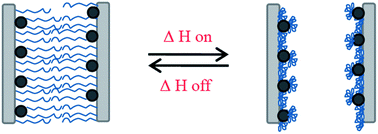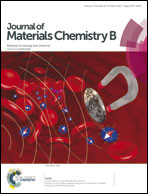Magnetic Fe3O4 nanoparticle heaters in smart porous membrane valves†
Abstract
The application of magnetic nanoparticles (NPs) in membrane technology is still very new and combinations of such NPs and separation membranes are essentially unexplored. By the integration of NPs into polymeric membranes it is possible to create new functionalities based on the synergies of the materials. Here nanoparticle polymer hybrid membranes were created by immobilizing (super)paramagnetic Fe3O4 NPs on the walls of track-etched polyethylene terephthalate pores and further functionalization with poly(N-isopropylacryl amide) (PNIPAAm). The hybrid system can be controlled via local heat generation by the NPs induced by an external high frequency electromagnetic field, i.e., effective membrane pore size can be switched by the magnetic field due to the synergy between the nanoparticle functionality and the temperature-responsive properties of PNIPAAm. Analytical characterizations showed a successful and stable NP integration and the feasibility of functionalization with grafted PNIPAAm in the presence of immobilized NPs on the membrane pore surface. The valve function of the nanoparticle polymer hybrid materials with an external control via a high frequency electromagnetic field was demonstrated in water permeability experiments, but such systems will have significant potential for other applications such as drug release or mass separation.


 Please wait while we load your content...
Please wait while we load your content...